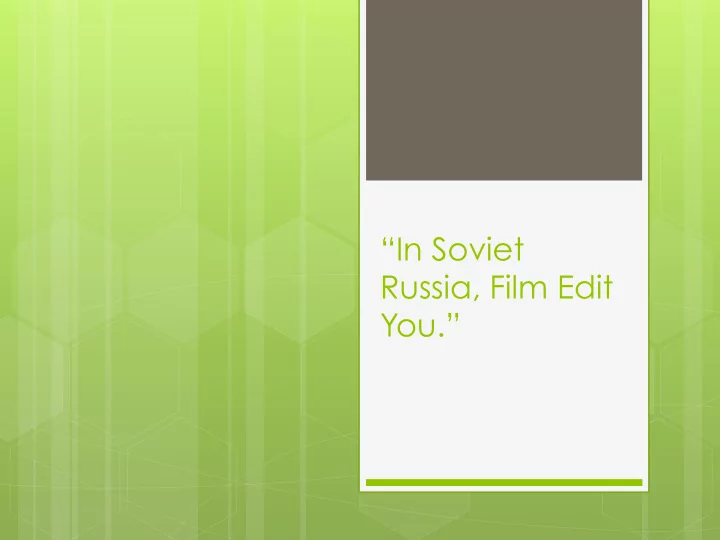

“In Soviet Russia, Film Edit You.”
A Time of Conflict! 1914-18 – WWI 1917 – Overthrow of Tsars, followed by various internal conflicts among the Bolsheviks, non-Bolshevik socialists and non-communists 1922 – Establishment of the USSR (Union of Soviet Socialist Republics)
Moscow Film School (VGIK) First Film School Agit-Prop for the state at a time when a vast proletariat population was illiterate Lev Kuloshov was a founding faculty Sergei Eisenstein studies under Kuloshov, and later teaches at the school
Kuloshov https://www.youtube.com/watch? v=_gGl3LJ7vHc - The Kuloshov Effect Editing can allow films to transcend space and time – What’s an example from yesterday’s screening?
Sergei Eisenstein “Father of Russian Film Theory” Filmmaker, Theorist and Marxist Believes that history moves forward through a never-ending series of conflicts also known as DIALECTICS: THESIS + ANTITHESIS = SYNTHESIS (shot 1) (shot 2) = MEANING (idea 1) (idea 2) = NEW IDEA
Dialectic Approach to Film Form Counterpoint and Irregularity pp. 51-54 Types of Conflict pp. 52-56 “Language is much closer to film than painting is.” pp. 60-62
Methods of Montage (it’s important to remember that they all build on each other!) Metric/Rhythmic Tonal/Overtonal Intellectual
Counterpoint and Irregularity pp. 51-54 Counterpoint: Juxtaposition of difference between different element. Each element reveals itself through juxtaposition. Irregularity: Reference to Esperanto – pg47 – Articulating difference and change over time with film at it’s most minute level. It appears seamless and smooth, but is actually filled with complexity.
Types of Conflict pp. 52-56 Conflict on the most minute level via the frame. Conflict between shots Graphic and Visual Conflicts Conflict on a thematic level Conflict on an intellectual or ideological level.
“Language is much closer to film than painting is.” pp. 60-62 Film is like a sentence: Each individual word isn’t inherently meaningful. The meaning is derived through the words/ frames in combination. Pg. 60 “…Nevertheless, in regard to the action as a whole, each fragment-piece is almost abstract. The more differentiated they are the more abstract they become, provoking no more than a certain association.”
Metric/Rhythmic Montage Metric: Shot length – Speed to give emotional effect. For example: Fast to create tension or slow for calm. Meant to operate on an emotional or physiological level. Rhythmic: Based on the action occurring within each shot. Tempo based on the length and content of the shot.
Tonal/Overtonal Tonal: pg. 80 – “Melodic Emotive” Using transitions between shots to create ambiance and mood or “tone.” Overtonal: A combination of the previous methods for overall emotional and intellectual impact. Distinction: Pg. 79 – Distinction between overall tone of the piece and something new that emerges.
Intellectual Over-arching ideas in conflict with each other. Meant to evoke emotion or persuade the viewer. From Dialectic Approach to Film Form: pg. 61-63 – Intellectual Montage allows us to undo and unravel an initial concepts.
Recommend
More recommend